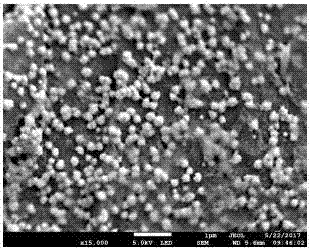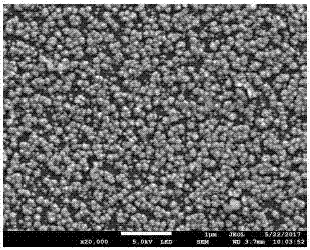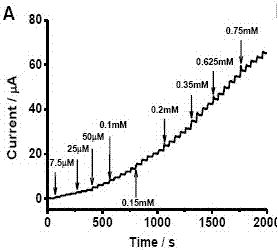Novel non-enzymatic glucose sensor
A glucose sensor, a new type of technology, applied in the fields of materials science and electrochemistry, can solve the problems of poor sensor performance, narrow linear range, and low sensitivity, and achieve high stability, low experimental condition requirements, and strong anti-interference ability
- Summary
- Abstract
- Description
- Claims
- Application Information
AI Technical Summary
Problems solved by technology
Method used
Image
Examples
Embodiment 1
[0021] refer to Figure 1 to Figure 3 , a novel enzyme-free glucose sensor for the experimental determination of glucose.
[0022] Insert the present invention into 8 mL of deoxygenated 0.02 M, pH 7.4 phosphate-buffered saline (PBS) solution, and continuously inject given different concentrations of glucose to obtain corresponding current responses. Experiments show that the invented new enzyme-free glucose sensor responds quickly to changes in glucose concentration, and the reduction current can reach 95% of the steady-state current within 3 seconds. image 3 It is a linear calibration curve graph between glucose concentration and detection current, and it is a linear calibration curve graph between ampere current and glucose concentration in the range of glucose concentration 0.0075μM to 0.235mM. see image 3 Show, the linear range 7.5 μ M~4.5 mM of the present invention to the mensuration of glucose, and fitting obtains its linear equation to be I (μ A)=0.466X+0.097, line...
Embodiment 2
[0024] refer to Figure 1~Figure 2 , Figure 4~Figure 6 and Table 1. A Novel Enzyme-Free Glucose Sensor for the Experimental Determination of Hydrogen Peroxide.
[0025] Insert the present invention into 0.02M, pH7.4 PBS solution, under the applied potential of 0.1 V, continuously add hydrogen peroxide of different concentrations to obtain the i-t current response curve, see Figure 4 . Depend on Figure 4 It can be seen that: when different concentrations of hydrogen peroxide are added to the PBS solution, the enzyme-free glucose sensor of the present invention responds to the analyte immediately, with a good, stable and sharply increased current response, and the response time is about 1s. This clearly demonstrates the fast electron transfer between the inventive electrode and hydrogen peroxide. see Figure 5 , from the linear calibration curve between the concentration of hydrogen peroxide and the detection current of the present invention, it can be found that the -...
PUM
| Property | Measurement | Unit |
|---|---|---|
| diameter | aaaaa | aaaaa |
| Sensitivity | aaaaa | aaaaa |
Abstract
Description
Claims
Application Information
 Login to View More
Login to View More - R&D
- Intellectual Property
- Life Sciences
- Materials
- Tech Scout
- Unparalleled Data Quality
- Higher Quality Content
- 60% Fewer Hallucinations
Browse by: Latest US Patents, China's latest patents, Technical Efficacy Thesaurus, Application Domain, Technology Topic, Popular Technical Reports.
© 2025 PatSnap. All rights reserved.Legal|Privacy policy|Modern Slavery Act Transparency Statement|Sitemap|About US| Contact US: help@patsnap.com



